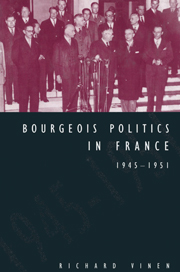Book contents
- Frontmatter
- Contents
- Preface
- List of abbreviations and French political groups
- 1 Introduction
- 2 A historiographic overview
- 3 International comparisons
- 4 Notables
- 5 Bourgeois parties and the female electorate
- 6 Organized business and politics
- 7 Administration
- 8 Opposition nationale
- 9 The Parti Républicain de la Liberté
- 10 Machine à ramasser les Pétainistes? The Mouvement Républicain Populaire and the conservative electorate
- 11 The Rassemblement des Gauches Républicaines
- 12 The Rassemblement du Peuple Français
- 13 Independents and Peasants
- 14 The Groupement de Défense des Contribuables
- 15 Conclusion
- Appendix. The electoral law of 1951 and apparentements
- Bibliography
- Index
10 - Machine à ramasser les Pétainistes? The Mouvement Républicain Populaire and the conservative electorate
Published online by Cambridge University Press: 06 July 2010
- Frontmatter
- Contents
- Preface
- List of abbreviations and French political groups
- 1 Introduction
- 2 A historiographic overview
- 3 International comparisons
- 4 Notables
- 5 Bourgeois parties and the female electorate
- 6 Organized business and politics
- 7 Administration
- 8 Opposition nationale
- 9 The Parti Républicain de la Liberté
- 10 Machine à ramasser les Pétainistes? The Mouvement Républicain Populaire and the conservative electorate
- 11 The Rassemblement des Gauches Républicaines
- 12 The Rassemblement du Peuple Français
- 13 Independents and Peasants
- 14 The Groupement de Défense des Contribuables
- 15 Conclusion
- Appendix. The electoral law of 1951 and apparentements
- Bibliography
- Index
Summary
Introduction
One of the most spectacular novelties of the Fourth Republic was the new Christian Democrat party: the Mouvement Républicain Populaire. The party gained 26 per cent of votes cast in the November 1946 election, which made it the second largest group in parliament after the Communist party, but this level of support proved impossible to maintain. Support for the party, as reflected in municipal elections, dropped in 1947 and in the general election of 1951 the MRP obtained only 12.5 per cent of votes cast. The nature of the electorate that propelled the MRP to such great, and short-lived, success has received little attention. Historians sympathetic to the MRP gloss over the subject while others simply take it for granted that the party was supported by ‘Millions of French conservatives, bewildered by the discrediting of their former leaders, were seeking a powerful bulwark against Communism and believed that they had found it in the MRP.’
This chapter will argue that the MRP's electorate was indeed a conservative one (or at least that it came from areas and social groups that had voted conservative before 1944 and did so again after 1951). However, it will also argue that the supporters of the MRP were characterized by a particular kind of conservatism as well as by attitudes that did not fit into any neat left/right model.
- Type
- Chapter
- Information
- Bourgeois Politics in France, 1945–1951 , pp. 137 - 172Publisher: Cambridge University PressPrint publication year: 1995

